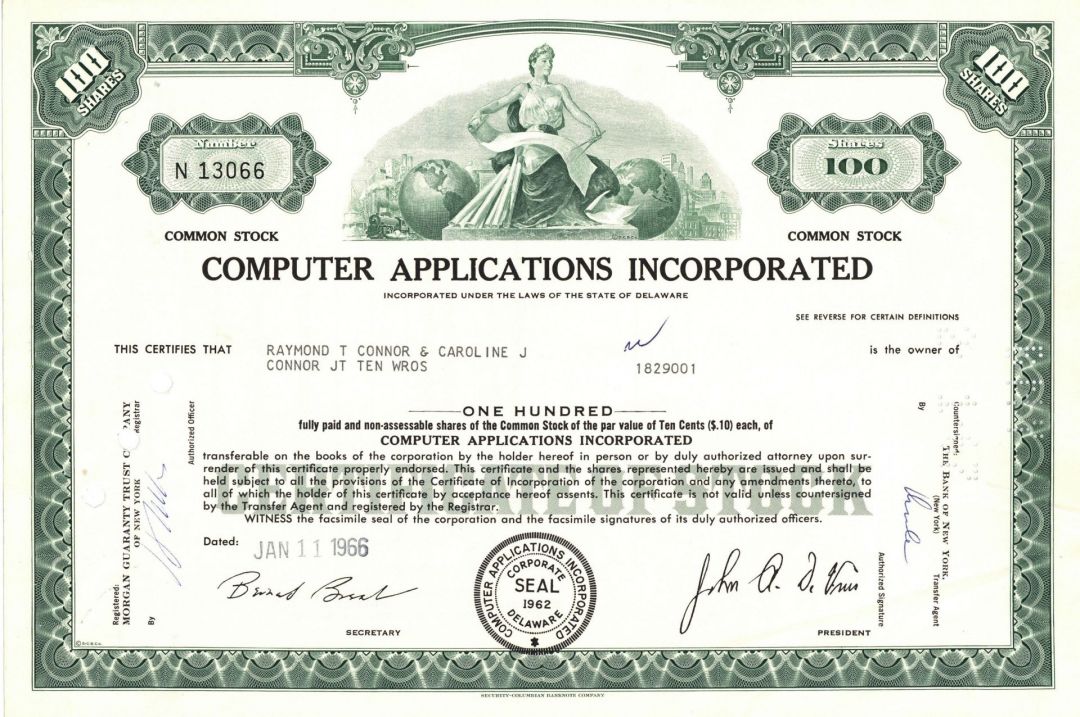Computer Applications Inc. - 1960's dated Technology Stock Certificate - Early Computer Age
Inv# GS6235 StockVery Early Computer Stock Certificate. The "fourth-generation" of digital electronic computers used microprocessors as the basis of their logic. The microprocessor has origins in the MOS integrated circuit (MOS IC) chip. Due to rapid MOSFET scaling, MOS IC chips rapidly increased in complexity at a rate predicted by Moore's law, leading to large-scale integration (LSI) with hundreds of transistors on a single MOS chip by the late 1960s. The application of MOS LSI chips to computing was the basis for the first microprocessors, as engineers began recognizing that a complete computer processor could be contained on a single MOS LSI chip.
The subject of exactly which device was the first microprocessor is contentious, partly due to lack of agreement on the exact definition of the term "microprocessor". The earliest multi-chip microprocessors were the Four-Phase Systems AL-1 in 1969 and Garrett AiResearch MP944 in 1970, developed with multiple MOS LSI chips. The first single-chip microprocessor was the Intel 4004, developed on a single PMOS LSI chip. It was designed and realized by Ted Hoff, Federico Faggin, Masatoshi Shima and Stanley Mazor at Intel, and released in 1971. Tadashi Sasaki and Masatoshi Shima at Busicom, a calculator manufacturer, had the initial insight that the CPU could be a single MOS LSI chip, supplied by Intel. While the earliest microprocessor ICs literally contained only the processor, i.e. the central processing unit, of a computer, their progressive development naturally led to chips containing most or all of the internal electronic parts of a computer. The integrated circuit in the image on the right, for example, an Intel 8742, is an 8-bit microcontroller that includes a CPU running at 12 MHz, 128 bytes of RAM, 2048 bytes of EPROM, and I/O in the same chip.
During the 1960s there was considerable overlap between second and third generation technologies. IBM implemented its IBM Solid Logic Technology modules in hybrid circuits for the IBM System/360 in 1964. As late as 1975, Sperry Univac continued the manufacture of second-generation machines such as the UNIVAC 494. The Burroughs large systems such as the B5000 were stack machines, which allowed for simpler programming. These pushdown automatons were also implemented in minicomputers and microprocessors later, which influenced programming language design. Minicomputers served as low-cost computer centers for industry, business and universities. It became possible to simulate analog circuits with the simulation program with integrated circuit emphasis, or SPICE (1971) on minicomputers, one of the programs for electronic design automation (EDA). The microprocessor led to the development of microcomputers, small, low-cost computers that could be owned by individuals and small businesses. Microcomputers, the first of which appeared in the 1970s, became ubiquitous in the 1980s and beyond. Read more at https://en.wikipedia.org/wiki/History_of_computing_hardware
A stock certificate is issued by businesses, usually companies. A stock is part of the permanent finance of a business. Normally, they are never repaid, and the investor can recover his/her money only by selling to another investor. Most stocks, or also called shares, earn dividends, at the business's discretion, depending on how well it has traded. A stockholder or shareholder is a part-owner of the business that issued the stock certificates.











Ebay ID: labarre_galleries